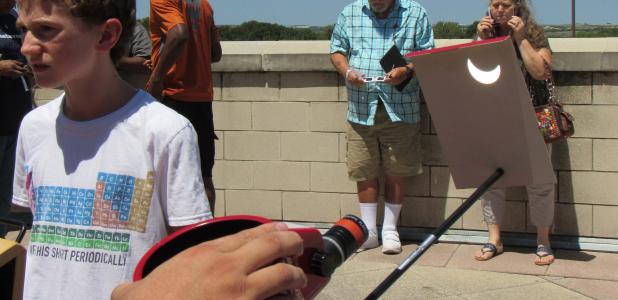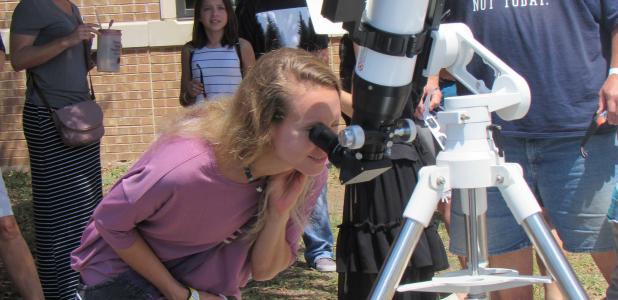Locals take in eclipse view at CTC's planetrium
By BRITTANY FHOLER
Cove Leader-Press
Central Texas College held a solar eclipse viewing on Monday for area residents at the Frank and Sue Mayborn Planetarium and Science Theater.
The event, for which doors opened at 10:30 a.m., started with a showing of their new program, “Totality”, about the history of eclipses and what causes them. Before and after the film, Mayborn astronomers Jay Huston and Warren Hart answered various questions about the moon and stars and eclipses.
The maximum capacity for the theater was 180, according to Hart. CTC originally sold out of tickets and glasses last Tuesday and had to turn people away the morning of the eclipse.
Dozens of people waited in the lobby while open seats were counted, until it was their turn to buy a ticket and glasses. By 11:30 a.m., there were still tickets available but not glasses.
When the film finished, guests had the opportunity to go outside to the front of the building and look through two different telescopes to see the moon pass over the sun. One telescope was a filtered white light telescope while the other was set for a specific wavelength, according to Huston. One allowed guests to look at the corona whereas the other allowed them to look at the photosphere.
Guests also could use their special glasses or go up the second-floor balcony and view the eclipse on paper through three different set ups using the shadows. If guests didn’t have glasses, they could still view the eclipse via the live feed from NASA in Kansas City, Missouri playing in the dome theater.
When looking at the ground, under a tree, guests could also see the effect of the eclipse with the crescent shapes made from the light shining through the leaves.
The path of totality of the eclipse didn’t run through Texas this year, with Central Texans only seeing less than 70 percent coverage of the sun by the moon. Come April 8, 2024, that will change, according to Hart and Huston. Killeen, and surrounding areas, will be in the path of totality of the first total solar eclipse in over 500 years, Hart said.
Huston explained that in the next 18 years, there will be 15-16 eclipses visible in the U.S., part of a Saros cycle, or how often an eclipse repeats itself, which takes 223 lunar orbital periods.
Monday’s eclipse was the nation’s first total solar eclipse since 1979 and the first one to cross from the Pacific Ocean to the Atlantic Ocean in 99 years.
Cindi Dunn and her husband, Jim, said they remembered the eclipse in 1979.
“Who knew that it was going to be 38 years later?” Cindi said. “I think this is so cool and I think the fact that they’re sharing with students how to do it...I mean we did the paper plate where you did the pin hole and watched it down, you know. I was in college and it was just a big reason to get together at the football field.”
Cindi said she thought it was fantastic that Texas will be in the path of totality in 2024.
“I have two sons who went through the NASA High School Aero Space Scholar Program and so they’re so into space and so into all of this, so for them to experience that in their lifetime, I think is wonderful,” she said.



